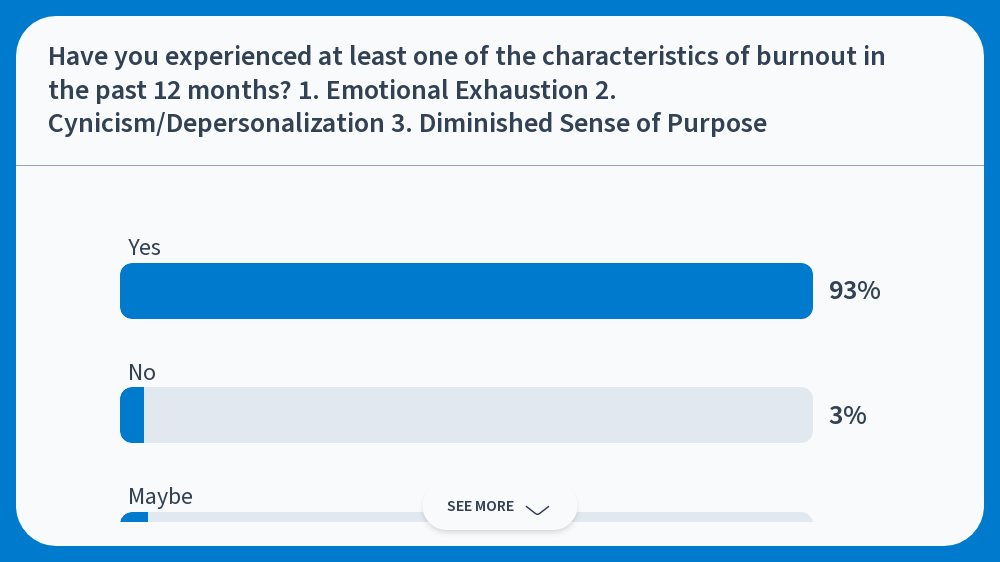Healthcare Burnout Blog and Resources
by Patrick Riecke
Healthcare workers and leaders are facing record levels of exhaustion, moral distress, and compassion fatigue.
This blog brings together practical tools, personal stories, and expert insights from burnout speaker and coach Patrick Riecke to help you prevent burnout, recover your sense of purpose, and restore wellbeing at work and beyond.
-
Let’s Talk About Healthcare Burnout: A Prevention and Recovery Guidebook by Rev. Patrick Riecke and Dr. Erin Alexander
This resource will guide your path to burnout prevention and recovery. This eBook provides actionable strategies, inspiring insights, and a clear path forward. Purchase your copy to begin transforming your experience.
-
Discover your level of burnout with our free online screening tool. This simple, science-backed assessment helps you understand emotional exhaustion, depersonalization, and personal accomplishment to identify your risk of burnout. Start your journey toward recovery today.
-
This affordable, life-changing mini-course helps you refocus your energy on what truly matters. Learn how to prioritize self-care and design a purpose-driven life while preventing burnout. Available exclusively for $24.99. Sign up here.
-
Whether you're an individual recovering from burnout or a leader looking to help your team, I offer tailored workshops, keynotes, and coaching. Let’s work together to create lasting change and improve wellbeing in your life or organization. Contact Patrick today.
-
Get personalized support through 1-on-1 executive coaching sessions designed to help you understand and combat burnout. Together, we’ll develop a plan to renew your energy, improve work-life balance, and thrive. Click here for coaching.
They are desperately crying for help
When you talk about burnout as openly as I do--these conversations are inevitable.
Once or twice a week, I find myself on the listening end of one of these conversations. The other person--spilling over with sadness, anger, or frustration about their jobs.
They aren't complaining. They are desperately crying for help.
"And then..."
"I don't know how much longer I can..."
"My family doesn't understand..."
"I think that whole thing just traumatized me..."
Panic attacks.
Heart arrythmias.
Strokes.
Depression and suicidal thoughts.
Leaders who cast blame on them instead of offering support.
Workloads that are inhumane.
Shifting goals--they never know when they are succeeding.
If the conversation goes on for an hour, I usually talk for about five minutes.
They have to get it out.
They feel safe talking with me, so it spills out.
Near the end of our time on the Zoom call or in the coffeeshop, they start apologizing.
"I'm so sorry, I've just rambled on for so long."
"I know other people have it worse, and I don't know why this has been so hard for me."
"I thought I could tell the story in five minutes, but I guess not. I am sorry I've wasted so much of your time."
The cascade of feelings and retelling of their traumas is predictable.
The absence of a supportive leader is common.
The presence of distressing work--not just stress, but DISTRESS--is always a primary characteristic.
But the apology at the end tells me so much.
They are used to shutting up and showing up.
Even though they are burnt to a crisp with no energy left, they "soldier on."
That's why our conversation is like a dam breaking.
And it's why they feel guilty taking my time.
They aren't used to being cared for.
Listened to.
Affirmed or acknowledged.
As we close our time together, they become effusive in their gratitude.
"Thank you so much, this helped me more than you know."
"You probably think I am crazy now, but thank you so much for listening to me."
Remember, I did almost nothing.
Nothing but listen.
Care.
Support.
Acknowledge.
Help them feel seen.
These are some of the best people I've ever known.
Nurses and nurse leaders.
Physicians.
Teachers and professors.
Healthcare leaders.
They've given so much for so long in a system that is built for moral distress and burnout.
Over the weekend, I remembered.
This is why I travel to provide keynotes and workshops on burnout.
This is why I built The Burnout Hub.
This is why Erin Alexander and I wrote the book.
Because when I hear these burnout stories from these amazing humans--it makes me so angry.
They deserve better.
They deserve to be seen.
To be supported.
To be, in a word, loved.
Marshawn Kneeland other people who are right on the edge
Last week, Dallas Cowboys defensive end, Marshawn Kneeland, died by an apparent suicide.
Two days earlier, he scored his first touchdown in the NFL on Monday Night Football.
I am an Indianapolis Colts fan. The Cowboys are my second LEAST favorite team (just above the New England Patriots).
But, the Cowboys quarterback, Dak Prescott, has always held my respect. He regularly speaks out about mental health, and his grief over his mother, and the trauma of losing his brother, Jace, to suicide in 2020.
I had never heard of Marshawn, but his story is heartbreakingly familiar.
A successful man, who seems to have everything, faces a mental health battle that costs his life.
When I was in my darkest days of burnout, I was depressed, anxious, and had days that I wasn't sure I could go on.
Dan Orlovsky, former backup QB for the Colts, said, “As an athlete, I would’ve never told you I was struggling. … I feel like I’m conditioned like that. I feel like, honestly, as a man I’m conditioned to be that way.”
I can relate. [Not to the athlete part--I can pull a hamstring just getting out of bed.]
I am thankful that I had support.
Thankful that I've had so many opportunities.
And a nearly perfect life.
But that didn't keep me from struggling.
Sometimes, I share the below photo when I speak.
It was taken when I was in a very dark place.
The casual onlooker would never have known.
I am smiling, dressed nice, sporting a fresh haircut, and enjoying the amazing rugby action of the Marian University Knights led by our son, Daniel Riecke.
So, just a reminder that some people who scored a touchdown on MNF, and some people who are leading well at your organization are...
right on the edge.
I got therapy.
I got medication.
I had to make some changes.
And it took years to get to where I am today.
I am glad I made it.
P.S. Kudos to the Colts and Courageous Healing, Inc. with Janell Lane, MA, LMHC and Aaron Lane, MSOL, LSW helping to #kickthestigma.
Bringing Dignity to Miscarriage: The Story of the Miscarriage Collection Cradle
“It was a great day for women.”
Laura Corcoran, creator of the Miscarriage Collection Cradle, and Kristen Riecke, the author of No Matter How Small: Understanding Miscarriage and Stillbirth
That’s how I’ve been describing the day we spent with Laura Corcoran, the creator of the Miscarriage Collection Cradle.
For anyone familiar with my feminist tendencies, you’ll fully understand my heart behind that statement.
One in four pregnancies ends in loss—most through early miscarriage. And for many women, the physical experience of that loss happens at home, alone.
They are told to “manage at home.”
Too often, they find themselves holding their baby’s remains in their hands, unsure what to do. Others watch helplessly as an automatic toilet flush takes their child from them forever.
Laura experienced miscarriage herself in her home in the U.K.
Kristen and I lived our own miscarriage story nearly 25 years ago. That grief became the soil from which books, support groups, and a hospital bereavement program grew.
But Laura’s grief led her somewhere else: to fix an age-old problem that shouldn’t exist anymore.
As an engineer, Laura refused to accept that the only option was to fish your dead baby out of the toilet with a kitchen sieve.
In defiance, she created the Miscarriage Collection Cradle, a dignified way for women to collect and preserve their baby’s remains—for burial, for genetic testing, or simply for peace.
Her cradle is now an approved medical device used in 15 hospitals across the United Kingdom.
And last week, she brought it to Indiana.
Kristen and I had the privilege of hosting her as she met with local physicians, midwives, nurses, doulas, and people who care deeply about women’s health. She demonstrated the cradle to Dr. Geoff Gordon, Dr. Tom Miller, Kathy Detweiler, Mindy Leatherman, Erin Ross, and so many others who leaned in to learn and to listen.
One of the most moving parts of the day came when we introduced Laura to our friend, John Lozo. John runs the Forever In Your Heart program, using 3D scanning to capture the hands and feet of loved ones—minutes before or after death.
He then uses a 3D printer to create keepsakes: tiny baby footprints, fingerprints pressed into silver necklaces, statues of a grandparent’s hand—ready to be held by loved ones.
Laura builds devices that protect dignity at the beginning of death. John preserves the memory of the ones we loved. Two people, on different continents, both using their hands and their heartbreak to serve the grieving.
I don’t have their engineering or technological skills. But watching them meet was one of the most hopeful moments I’ve experienced in a long time.
Another beautiful part of this story is how it all began: on LinkedIn. The algorithm paired them together--the author of No Matter How Small and the engineer of a product collecting tiny people.
A good day for women and those who love them
To conclude the day, Kristen's sister, who desperately wishes she would have had a Miscarriage Collection Cradle in the past, drove for four hours to have dinner with Laura, Kristen, and (to a lesser extent) me.
Their embrace brought tears to our eyes--One of the millions of women in history who needed support during miscarriage and the one woman in history to develop a device to bring dignity to miscarried remains and the woman who carry them.
Our world seems so dark at times, and I can lose hope.
Yesterday. Yesterday was not one of those days.
For more on miscarriage and stillbirth, visit KristenRiecke.com for the internet’s most exhaustive list of resources on this topic.
Burnout Is Not Rare—It’s the Rule
Recent polls from my speaking events show what many of us already feel but don’t always say out loud: burnout is nearly universal. In healthcare, education, and other service-focused industries, almost everyone has experienced it in the past year. These numbers aren’t just statistics—they’re a wake-up call that burnout is no longer the exception. It’s the rule.
+++
At a recent event, I asked the audience a simple question: “Have you felt burned out at all in the past 12 months?”
The responses were overwhelming. Out of more than 120 participants, only 3% said no. Everyone else (93-96%) admitted they had.
live poll results from a recent speaking engagement
At another event, 224 people answered the same question. Just 8 of them said they hadn’t experienced burnout. That means 216 people had.
Take a moment to let that sink in.
If we’re still telling ourselves that burnout is rare, that it only happens occasionally, or that it’s a sign of weakness, we’re lying to ourselves. The data and the lived experiences of people in the room prove otherwise.
Burnout has become an epidemic. It’s not just in healthcare (though the numbers there are staggering). It’s also affecting service-oriented industries across the board: K–12 education, higher education, and law enforcement, to name just a few.
The first step in solving a problem is acknowledging it exists. When it comes to burnout, denial is costly. People are suffering, workplaces are struggling, and communities are paying the price.
The good news? There are solutions. Recovery is possible. Prevention is possible. But none of that matters unless we start by facing the reality: burnout isn’t the exception. It’s the norm.
And it’s time we do something about it.
10 Meaningful Ways to Recognize Your Coworkers and Prevent Burnout at Work
I heard the conversation from down the hall. She was being so kind to the grieving family. “That’s how I want to be treated when my loved one dies,” I told my coworker when she got off the phone.
It wasn’t fancy. It wasn’t public. But she knew I had noticed.
And that her work mattered.
That’s the thing about recognition—it’s rarely about the reward. It’s about being seen.
In a time when healthcare, education, and nearly every profession are battling burnout, simple acknowledgment can become a lifeline. Recognition can’t fix everything, but it can absolutely shift the culture.
If you want to build a workplace where people stay engaged, here are 10 meaningful ways to recognize your coworkers—simple actions that reinforce connection, purpose, and wellbeing.
1. Start with Specific Praise
Generic compliments (“Good job!”) are easy to forget. Specific ones stick.
Say why you appreciated something:
“I noticed how calmly you handled that family’s frustration today. That kind of presence helps everyone.”
Recognition becomes powerful when it’s personal and timely.
2. Celebrate Effort, Not Just Outcomes
When leaders only acknowledge success, people learn to hide their struggles.
Recognize the process, too. The late-night problem-solving, the teamwork, the persistence through change.
Burnout thrives where people feel their effort goes unseen.
3. Make Peer Recognition Normal
Not every moment of appreciation should come from a supervisor.
Set up ways for coworkers to thank each other—a shared bulletin board, a digital shoutout channel, or five minutes during team meetings to share quick recognitions.
Peer-to-peer appreciation builds a culture of mutual respect.
4. Recognize in Real Time
Don’t wait for annual awards or quarterly reviews.
Catch someone doing something good and name it immediately.
A quick text, Teams message, or hallway thank-you creates more impact than a delayed acknowledgment six weeks later.
5. Include Everyone—Not Just the High Performers
Recognition should never feel like a popularity contest.
Make a point to appreciate quieter contributors; the ones who keep things running smoothly, help others, or lift morale in subtle ways.
True inclusion in recognition is one of the best forms of psychological safety.
6. Make It Visible (When Appropriate)
Public recognition has power when done right.
Consider a rotating “Wall of Thanks,” a newsletter section for shoutouts, or a quick mention in a staff meeting.
Always check for comfort levels. Some people would rather receive private acknowledgment.
7. Give Recognition That Matches the Person
Some people value words. Others value time or flexibility.
A handwritten note, a few extra minutes to breathe, or letting someone leave early after a rough shift—all count.
Meaningful recognition meets people where they are.
8. Connect Recognition to Mission
We all crave purpose.
When you thank someone, link their action to your organization’s mission:
“The way you supported that new hire reflects exactly why our team matters.”
This turns recognition into alignment—and alignment fuels engagement.
9. Create Rituals of Appreciation
Build recognition into the rhythm of your team:
End-of-week reflections
Monthly “gratitude rounds”
A “three thank-yous” rule in team meetings
Rituals remind everyone that noticing each other is part of the job.
10. Recognize Yourself, Too
Leaders who never receive recognition often struggle to give it.
Take time to reflect on your own progress, lessons, and resilience.
Self-recognition keeps you grounded—and models healthy self-awareness for your team.
Recognition as Burnout Prevention
Recognition isn’t fluff. It’s strategy.
When people feel valued, their stress response softens, creativity returns, and collaboration improves.
Organizations that weave recognition into daily life see lower turnover, higher engagement, and fewer symptoms of burnout.
And while it’s easy to think of recognition as “one more thing” to do, the truth is that it is the work.
When people know they matter, they can handle the hard days better.
If you’d like to keep the momentum going, you can purchase the full PDF of 101 Ways to Provide Recognition here, or sign up for The Burnout Hub and receive it for free.







